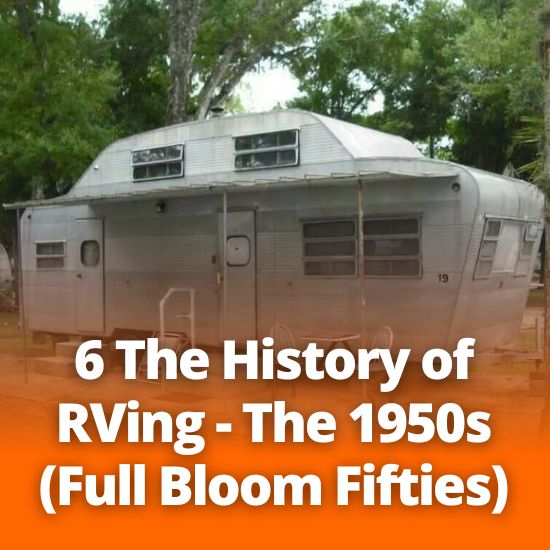
6 The History of RVing - The 1950s (Full Bloom Fifties)
Welcome to the fifties, the decade of sock hops, poodle skirts, Marilyn Monroe, and the Silver Age of Disney Animation (and the Cold War, but we don’t talk about that).
Starting this decade, the Alberta provincial government began establishing new provincial parks (by 1971 there were 46 added to the map). All with the intention for Albertans to enjoy the outdoors. These parks offered everything from playgrounds to campgrounds, access to boating, fishing, hiking, and a laundry list of other activities.
Good thing too, because as WWII came to a close RVs once again became a popular cheap travel option for young families and returning soldiers hoping to get back to normal. So, RV manufacturers took this boom to heart and began adding more improvements as standard across their models. Plumbing and refrigeration were the big ones unsurprisingly.
And it wasn’t just the standard models that got a makeover, luxury evolved. Bigger, better, magnificence; home decor, multiple bedrooms and bathrooms – and even one with a portable pool and diving board!
We’re speaking of course of the 1952 Executive Flagship which deserves its own post (and will get one, I assure you), but for a brief explanation: the one of a kind motorhome has been lost to time but in its heyday was priced at $75,000 USD (yeah, do that inflation calculation). Created by William MacDonald of the Mid-States Corporation, the 65-foot long RV about 18 tons (for the record, an adult African elephant, the largest land animal on Earth, only weighs a max of 7 tons) and had:
- 2 full bathrooms
- Bar and lounge
- Dining room
- Rooftop platform (which could act as a sundeck or a HELIPAD – what even…)
- 3 separate sleeping areas

But that’s the far end of the spectrum when it came to elevated luxury, there were plenty of more sane options on the market. RVs expanded overall in size and length (with 10-foot wide trailers showing up somewhere between ‘53 and ‘54), with improved living spaces, more indulgent decor and finishes, and beyond the plumbing (including holding tanks, at last) and refrigeration (well, ice boxes – onboard refrigeration didn’t become really widely available until the late ‘60s) there were also generators, full kitchens, and bathrooms added to floor plans.
If you recall the 30s were where trailers started to become “travel homes,” by a slim margin, the fifties might as well be called “When Size Matters,” with the decade creating a defined line between trailers for full time living and vacationing. Travel trailers kept their small footprint, but bigger units (house trailers or mobile homes) grew.
Interestingly enough, you’re actually more likely to find a vintage trailer tagged with a 50s year than any decade previous, with older models either gone or so disintegrated you wouldn’t be able to tell them apart.
Now let’s explore some notable RVs of the fifties, and how they demonstrate some of these advancements.
1951 Landola Trailers
There were two models of these bad boys, 32 and 37-feet long. Both had ventilating style picture windows and an aluminum exterior.
The 37-foot Model 800 contained a triple-fold door to create a private bedroom, as well as containing a full restroom with shower and toilet, and then a “deluxe” kitchen with an 8 cu-ft electric fridge.
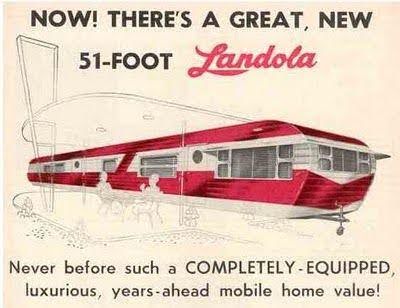
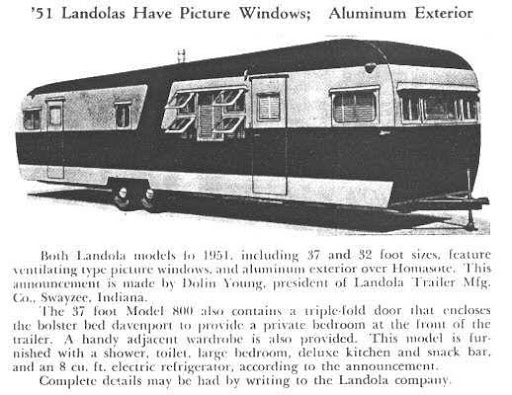
Custom Builds and the Birth of Motorhomes
Just because RV manufacturers continued to flourish, custom builds continued (as they always will). School buses were a popular base, like this Ford 1952:
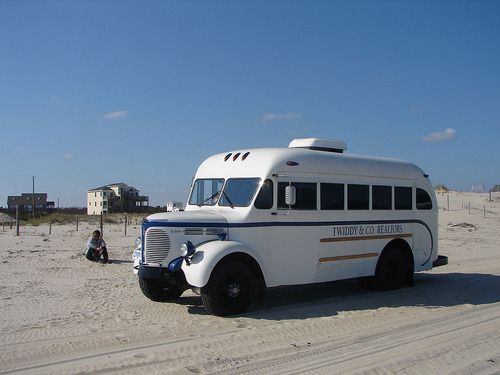
Ray Frank, 1953
Prior to the 50s, we’ve seen iterations of house cars that, through a modern gaze, can be considered ‘motorhomes,’ but their true birth is thanks to a man named Ray Frank, the owner of a small trailer manufacturing company out of Brown City, Michigan. In ‘53, he decided to build an all-weather travel vehicle for his family. Sitting on a Dodge truck chassis, he called it a “motor home” (before this, self-propelled RVs were considered “house cars”). Built solely for his family’s use, it became incredibly popular as they traveled gaining interest from campground neighbors to other motorists on the road! People were so intrigued that after just a few family trips, Frank began looking into sourcing component suppliers to begin manufacturing them for the public.
The “motor home” was an entirely unique build, even compared to its motorized predecessors. Designed from the ground up to be a motorized RV (as in it was not a trailer with additional added wheels and engine as the early house cars, or a converted bus or truck as the Ford model we mentioned earlier).
To achieve his venture, Frank went directly to the Dodge Division of Chrysler Corporation to investigate the possibility of bulk purchasing bare truck chassis. Dodge refused to sell him chassis directly, instead referring him to a Dodge truck dealer named Lloyd Bridges. From him, Ray Frank negotiated a contract for his first 100 chassis to begin building.
Now, rolling back just a bit: house cars before this had all been custom made or converted since the early 1920s, making Ray’s new motorhomes the first motorized RVs built expressly to be commercially distributed and sold. Lloyd Bridges even signed on to be one of the first dealers; the dealership that was created by that original order and purchase of completed coaches continues to this day: Lloyd Bridges Traveland is located in Michigan and was purchased by Camping World back in 2021.
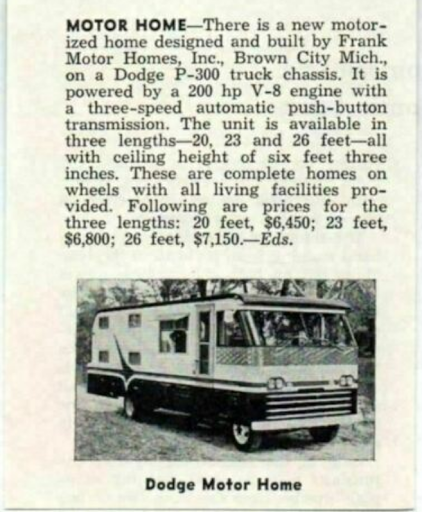
A shorter lived manufacturer was Gemco Engineer & Manufacturing Co. in Cincinnati. They built the two-story Space Queen trailer for only a single year; it was 26-feet long and 8-feet wide with a center bedroom compartment raised to 19-feet in height. It included a full kitchen, living room, and bathroom on the first floor, with two double bed bedrooms on the second.
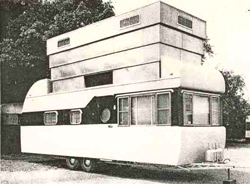
But the Queen wasn’t the last two-story, Richardson Homes Corp. in Elkhart, Indiana created an RV in 1955 called the Richardson Regent Bi-Level. Capable of sleeping eight people, it had two bedrooms upstairs with a rear balcony, a master bedroom downstairs with a bathroom and kitchen in the middle, and living room in the front. Wanting to stay competitive, it was designed to be pulled without requiring an oversize permit.

Don Hall, Alaskan Campers
Of course, bigger doesn’t necessarily mean better. In 1953, Don Hall designed a pop-up truck camper for his own three-month trip to Alaska. Proving the longevity of desire for a smaller RV, he started building them thanks to public demand in 1958.

The first unit was constructed with a hydraulic system to raise and lower the top, allowing for interior standing room when set up, but lowering the camper roof below the truck cab by a few inches. This design reduced wind resistance and improved gas mileage.
Within five years he had five factories building Alaskan Campers, and in another two years there were two more factories built in Canada with two factory outlets opened.

(1951 Schult ‘Dwellavan’)
And of course, we can’t forget good old Schult Trailer Company (remember them? Started back in 1934? The thirties are here if you need a refresh). But they officially evolved into the Schult Mobile Home Company in 1957, turning its focus entirely to the manufactured housing industry; they continue today as Schult Homes.